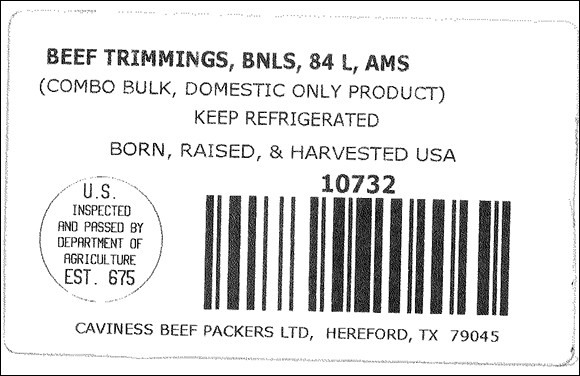WASHINGTON, 2016-Sep-28 — /EPR Retail News/ — Caviness Beef Packers, a Hereford, Texas establishment, is recalling approximately 2,100 pounds of boneless beef trim products that may be contaminated withE. coli O103, the U.S. Department of Agriculture’s Food Safety and Inspection Service (FSIS) announced today ( Sept. 27, 2016).
- The 2,100-lb. Combo Bin of “boneless beef trim 84L” products were produced on September 14, 2016 and further processed into ground beef products by another establishment. The recalling establishment has control of all but 320 pounds of ground beef products.
- 10 lb. chub – 73% Regular Ground Beef products with a “Use By” or “Freeze By” date of October 10, 2016 and bear UPC number 52846-48935.
- 2-3 lb. tray pack of – 73% Regular Ground Beef products with a “Sell By” date of September 28, 2016 and bear UPC number 2-01656-00000.
- 1.5 lb. tray pack of – 73% Regular Ground Beef products with a “Sell By” date of September 28, 2016 and bear UPC number 2-01654-00000.
The products subject to this recall were further processed by a firm other than Caviness Beef Packers, “EST. 675” and may not bear the establishment number “EST. 675”, on products available for direct consumer purchase. These products were shipped to retail locations in Texas.
The problem was discovered when FSIS was notified of a USDA’s Agricultural Marketing Service (AMS) sample that tested positive for E. coli 0103. Because the company works with the AMS Commodity Program, AMS did routine microbiological testing. This shipment of beef was never intended for the National School Lunch Program (NLSP) and no sales were made to the NLSP. There have been no confirmed reports of adverse reactions due to consumption of these products.
Many clinical laboratories do not test for non-O157 Shiga toxin-producing E. coli (STEC), such as STEC O103 because it is harder to identify than STEC O157. People can become ill from STECs 2–8 days (average of 3–4 days) after consuming the organism. Most people infected with STEC O103 develop diarrhea (often bloody), and vomiting. Some illnesses last longer and can be more severe. Infection is usually diagnosed by testing of a stool sample. Vigorous rehydration and other supportive care is the usual treatment; antibiotic treatment is generally not recommended.
Most people recover within a week, but, rarely, some develop a more severe infection. Hemolytic uremic syndrome (HUS) is uncommon with O103 infection. HUS can occur in people of any age but is most common in children under 5 years old, older adults and persons with weakened immune systems. It is marked by easy bruising, pallor, and decreased urine output. Persons who experience these symptoms should seek emergency medical care immediately.
FSIS and the company are concerned that some product may be frozen and in consumers’ freezers.
Consumers who have purchased these products are urged not to consume them. These products should be thrown away or returned to the place of purchase.
FSIS routinely conducts recall effectiveness checks to verify recalling firms notify their customers of the recall and that steps are taken to make certain that the product is no longer available to consumers. When available, the retail distribution list(s) will be posted on the FSIS website at www.fsis.usda.gov/recalls.
FSIS advises all consumers to safely prepare their raw meat products, including fresh and frozen, and only consume ground beef that has been cooked to a temperature of 160° F. The only way to confirm that ground beef is cooked to a temperature high enough to kill harmful bacteria is to use a food thermometer that measures internal temperature, http://1.usa.gov/1cDxcDQ.
Media and consumers with questions regarding the recall can contact Trevor Caviness, President, at (806) 372 – 5781.
Consumers with food safety questions can “Ask Karen,” the FSIS virtual representative available 24 hours a day at AskKaren.gov or via smartphone at m.askkaren.gov. The toll-free USDA Meat and Poultry Hotline 1-888-MPHotline (1-888-674-6854) is available in English and Spanish and can be reached from 10 a.m. to 4 p.m. (Eastern Time) Monday through Friday. Recorded food safety messages are available 24 hours a day. The online Electronic Consumer Complaint Monitoring System can be accessed 24 hours a day at: http://www.fsis.usda.gov/reportproblem.
|
PREPARING PRODUCT FOR SAFE CONSUMPTION USDA Meat and Poultry Hotline 1-888-MPHOTLINE or visit www.fsis.usda.gov Wash hands with warm, soapy water for at least 20 seconds before and after handling raw meat and poultry. Wash cutting boards, dishes and utensils with hot, soapy water. Immediately clean spills. Keep raw meat, fish and poultry away from other food that will not be cooked. Use separate cutting boards for raw meat, poultry and egg products and cooked foods. Color is NOT a reliable indicator that meat has been cooked to a temperature high enough to kill harmful bacteria. The only way to be sure the meat or poultry is cooked to a high enough temperature to kill harmful bacteria is to use a thermometer to measure the internal temperature.
Refrigerate raw meat and poultry within two hours after purchase or one hour if temperatures exceed 90º F. Refrigerate cooked meat and poultry within two hours after cooking. |
| USDA Recall Classifications | ||
| Class I | This is a health hazard situation where there is a reasonable probability that the use of the product will cause serious, adverse health consequences or death. | |
| Class II | This is a health hazard situation where there is a remote probability of adverse health consequences from the use of the product. | |
| Class III | This is a situation where the use of the product will not cause adverse health consequences. | |
Contact:
Congressional and Public Affairs
Allie Ryan
(202) 720-9113
Press@fsis.usda.gov
Source: USDA
###
